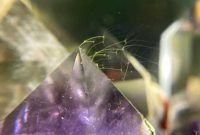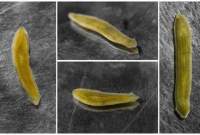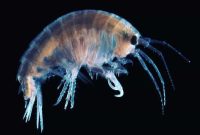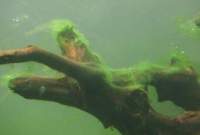Seeing some strange critters in the planted tank may make aquarists worried and hope any awful things never happen there. However, lack of information and experience can become a disadvantage because not all worms that appear in freshwater aquariums are bad.
For example, detritus worms are common creatures in the aquarium world, even though their presence is unpleasant for some tank owners due to their appearance and numbers that sometimes can not be controlled. However, they are still quite beneficial and may help the owner to handle certain problems.
If you are looking for specific information about them and want to get rid of these detritus worms, this article may help you. So, stay watching this article.
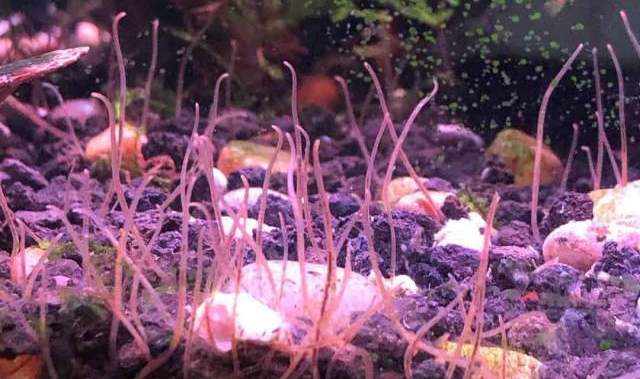
TABLE OF CONTENTS
What Are Detritus Worms
Most detritus worms belong to the family of tubeworms (annelids). However, this common name can also be applied to other species of worm that come from another phylum that lives in detritus in the aquarium ecosystems.
Detritus worms from the member of annelids phylum indicated they are close relatives to earthworms, sludge worms, leeches, and ragworms, which can be identified by their similar physical characteristics and reproductive abilities.
Their body shapes look like earthworm bodies, which are round and segmented, moving through the substrates with white color, thinner, and tiny size about 3/16 inch earthworms.
The family of clitellate oligochaete worms that are usually called Naididae (including the former family of Tubificidae) are the most commonly seen in home aquariums. This family consists of 800 species, while if it combined with other families, it difficult to count.
These creatures occupying saltwater and freshwater environments, they are great scavengers; thrive well in the aquarium with uncontrolled detritus infestation, including fish feces, uneaten food, and even dead plants and fish.
While in the planted tanks, you can see them floating in the middle level of the aquarium water like flying white threads, wriggling in the substrate, or even sticking on the filter media. Even though, detritus worms are harmless.
They are hermaphroditic, which means detritus worms have female and male reproductive organs, similar to earthworms.
Detritus Worm Appearances
Due to many species that are labeled as detritus worms, of course, each species has certain body characteristics that are different from other species. Some species have similar body shapes to common worms; some need a microscope to be seen because it is hard to notice them with bare eyes.
Note: Detritus worms have tens of thousands of species that live in tropical environments; their size ranges from 1 millimeter (0.25 inch) to 50 mm or 2 inches long. Besides, they also vary in color; some can be black, red, white, and brown, and even some can have unusual body shapes or skin tones.
Detritus Worm Behavior And Temperaments
Most members under these worm types often do almost all of their activities at night or in dim lighting with minimal disturbances, which they can tolerate.
Meanwhile, when the aquatic livestock is active during the daylight, these worms dig the substrate and then enter the holes to hide from the predators. Sometimes, they also stick on the wall or hide in the filter media.
Detritus worms are categorized as aquarium pests; they love dirty tanks with imbalanced environments. These tiny pests look weird and repulsive, but only about that. They do not significantly impact aquarium fauna and flora. Instead, they can be slightly useful for tank ecosystems.
Are Detritus Worms Good or Bad For Aquarium?
As mentioned above, these tiny critters do not harm fish, snails, shrimps, or other aquarium populations. In fact, they are excellent food sources for your fish and fry, which are rich in protein that promotes their growth rates.
Furthermore, detritus worms also play a role as a clean-up crew by consuming tiny particles of bioload on the tank floor. They will feed on any organic waste, such as debris and leftover food, and break it down.
However, when they are overpopulated, this may become a problem. Their large number can cause oxygen depletion, so your fish should compete with them to absorb the O2 in the water.
Of course, the high population of these worms makes your planted tank unsightly. Do not worry; this condition usually happens when your aquarium is too dirty and leaves it without any treatment.
Are Detritus Worms Harmful To Humans?
Most types of detritus worms are safe for human beings. Most of them can only live in water and die if filtered out of the aquarium; some might survive for a while when out of the tank before they are actually dead.
When the aquarium keepers put their hands into the water, these worms can attach to it but cannot go through the skin or suck the blood like leeches. Once the aquarium work is done, the keepers should wash their hands entirely with antibacterial soap to protect them from unwanted things.
Types Of Detritus Worms
According to a trusted site, there are several common types of detritus worms that are usually seen live in aquariums, especially in freshwater ecosystems; let’s begin.
Brown Or Red Worms
Due to their similar body color, these aquatic worms are often confused with the dangerous nematode worms, capilaria or camallanus. These pathogenic worms are only found in fish and are able to kill them.
The camallanus and capilaria have slender body-shape and are featureless; they do not move inside the aquarium fish or even swim in the water. If you are doing a treatment to paralyze them with some cures, once these pests are paralyzed, you will see them motionless on the tank floor.
Those characteristics are different from the true red or brown worms in the title above. They are annelida worms, which are reddish or reddish brown in coloration with long thin bodies and relatively doing active movements in the aquarium. Of course, these creatures are harmless. The easy way to distinguish both of them is from their motion. So, do not panic when you see small reddish worms moving and living in your aquariums.
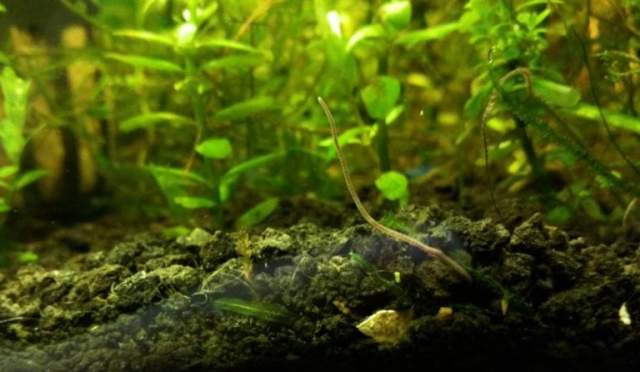
Brown ‘Detritus Worms’
In other cases, you may find some long, straight, brown worms gathering together in a particular spot inside your tank. These creatures are probably just common tubifex worms that can not affect the aquarium ecosystem. It usually indicates that you feed your livestock too much.
During the maintenance period, you might look at a population of reddish brown worms that occupy the aquarium filter and go out when cleaning it. Do not panic if it happens; perhaps they are another type of tubifex worm and definitely safe.
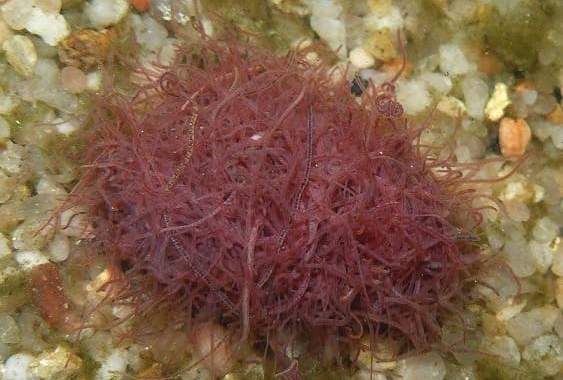
Tubeworms
When you observe aquatic plants and see a few unsightly brown stationary tubes sticking above them, stay calm. It is made by one of the tiny, harmless detritus worms family, and they live there. Sometimes, you will see some of their body parts extend out from the tubes. Typically, these worms are long, thin, and have white body coloration. Besides, they may also build their tube-shaped house on the substrate.
The worms that inhabit these tubes are a type of detritus annelid worm named tubifex or naidid worm. They belong to the annelida phylum, naididae family, and tubifex genus. Some people call them sewage or sludge worms; they consume decomposed organic matter around their house by extending their front ends from it.
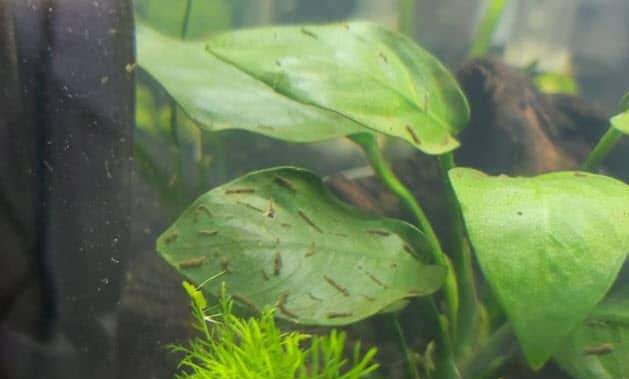
Other Types of Detritus Worms
Most of the detritus worms are members of tubeworms. However, there are several types of them that originate from another type, that is, roundworm (phylum nematodes) and flatworm (phylum planaria or rhabdocoelas, although they are rare). Nonetheless, both of those types are extremely rare to occur in planted tanks. You should be careful if found some small flatworms living in the aquarium; they might be the true planaria parasitic, which is a dangerous critter for your livestock, especially shrimps and snails.
Common Problems That Causing Detritus Worms to Invade Aquariums
Detritus worms can be introduced into the tanks in many ways, hitchhike to the new plants, fish, and water of fish bag that you added; that’s all their favorite way to go. They are excellent hitchhikers, so make sure to quarantine or disinfect any newer population before adding to the aquarium. In some instances, their eggs or themselves can hide inside the substrate from another contaminated tank or outdoor land that you added, then wait for the perfect time to raise in your aquarium.
Overfeeding and bad water quality are two of the main issues that cause them to attack our tanks. Ensure that the livestock is fed sufficiently and that the tank is always clean by routine maintenance activity.
How To Get Rid Of Detritus Worms From Your Tanks
Panic is usual for the newer aquascapers when they find some detritus worms slithering on the substrate, but they should not be over-panicked. These worms do not hurt your fish; they can even benefit the tank ecosystem. We suggest to reduce their population to avoid possible horrible effects.
Improve The Maintenance Practices
Devoting more effort to the maintenance period is effective in wiping out them. Scrub all objects in the tank, such as glass walls, driftwood, rocks, and other ornaments, until it is all clean. Suck up every debris and algae using the gravel cleaners; it also can pull the worms underneath the substrate. This method will be more effective on large granule substrate types such as gravel, limestone, marble, and crushed coral.
In order to get rid of the worms from the sandy substrate is by installing a long lift tube that is installed on the gravel cleaner; then, kink the drain hose to slow down the water flow. It aims to block sand from escaping through the vacuum, and it still pulls out the aquarium waste and worms.
Regular Water Change
You should change the water to complete the regular maintenance practices. Periodic water change will keep the water fresh and clean, creating an intolerable environment for detritus worms to live.
The water change frequency depends on a few aspects, such as aquarium size, tank equipment level, fish population, rate of waste produced, etc. Up to 30 percent weekly water change is advised to keep the aquarium ecosystem stay healthy; this is more proper for low-tech tanks.
But if your aquascape tank is in horrible condition with many worms and dirty, extreme water change until 50% is recommended. This can help to get rid of detritus worms population and turn back the water quality.
Remember this: if you have a shrimp tank, you do not follow the water change rule above; it can cause a molting problem to them. The suggested water change level for the shrimp aquarium is about 10% every two weeks or more, depending on the condition.
Reverse osmosis water is a good choice to substitute the old water; it is free from chemical toxins that are harmful to livestock. You can convert tap water at your home into it using an RO water filtration system that you can buy from online stores like Amazon.
Improve Filtration System
Selecting a water filter is significant in building a planted tank; the suitable filtration system will provide a reasonable oxygen rate, remove organic and organic waste, decrease harmful substance levels, and make a water current that helps fish breathe better.
This tool is vital for community aquariums that have to feed multiple times per day, which usually can lead to the accumulation of leftover food at the substrate. Using a poor filter will impact water quality and increase the decomposed matter, which can trigger the explosion of the detritus worm populations.
While the filter with over powerful strength could suck the fish, destroying the plants and decorations. Well, choose the capable and efficient aquarium filter (containing bio and mechanical filtration) to deal with the pollutants and these worms.
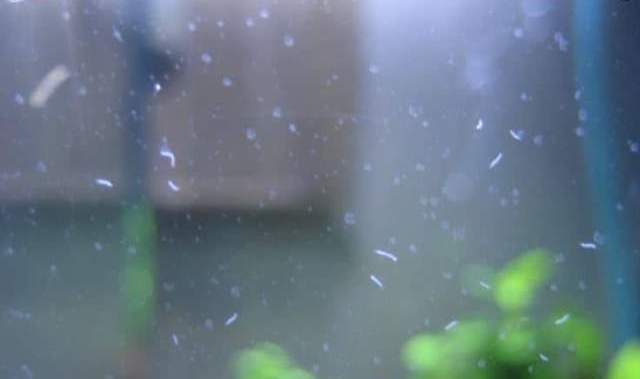
Stop Overfeeding Your Livestock
Overfeeding is a bad habit in keeping fish. Not only does it cause the ecosystem to become imbalanced, but it can also harm your fish and plants. Serving fish food too much may cause digestive issues and constipation to livestock, leading fish waste and food residues to sink to the substrate and then accumulate there, providing food sources for detritus worm colonies to be established.
Feed your livestock twice daily; if any uneaten food remains after 10 minutes, remove it soon so that the detritus worms do not devour it. This only applies to community tanks; for shrimp aquariums, the food can be left for 2 – 3 hours inside the tank before you clean up the leftovers.
Reducing fish diets will reduce the production of waste which helps in maintaining the quality of water and stopping food sources for these worms.
Overstocking Your Aquarium
We advised using this method when detritus worms are overpopulated and doing so in a short period. Overstocking your tank with fish and invertebrates can decrease the number of them, although it also can cause excess waste production, which affects water quality and causes other serious issues, so think again before deciding to go this way.
Raise Up Carbon Dioxide And Temperature Tricks
Some hobbyists try to elevate the CO2 level so that the dissolved oxygen in the water is lower significantly, making detritus worms underneath the substrate come out and swim for O2. In this situation, it will make it easy to catch or siphon them up from the tank.
Raising the water temperature by about 15+ degrees will make them stressed; remember, they do not dislike warm conditions. Unfortunately, both methods can threaten livestock and plants, so be careful when practicing these.
Adding Detritus Worm Predators
In the wild, they have natural enemies that you can put into your tank to hunt them. Most of the aquascape fish will eat them when facing up. Other species like crayfish, crabs, frogs, and certain mollusks like assassin snails also prey on them. Some common fish that often predate them, including
- Guppy
- Molly
- Platy
- Pea Puffer
- Licorice Gourami
- Samurai Gourami
- Pearl Gourami
- Dwarf Gourami
- Honey Gourami
- Angelfish
- Corydoras
- Bettas
- Tetra Species
Keep in mind they also may become an issue for shrimplets and adult ones, while bigger fish like giant discus or large gourami are not too interested in detritus worms.
Use Chemical Remover
It’s really unrecommended to use this way to fight the detritus worms. Not only does it kill the worms, but it also can exterminate your pets entirely. Embattle this pest using toxic medications is a terrible practice; remember, they still positively impact the ecosystem lifecycle.
Below are several products that are usually sold in the trade to eliminate detritus worms
- SOBAKEN Genchem No-Planaria
- Benibachi Planaria Zero
- Panacur C Canin Dewormer (Fenbendazole)
- Canine Dewormer Safe-Guard
- PraziPro
- AAP Dyacide
- Hydrogen Peroxide
Consider carefully the feedback that you can get before taking it this way. To learn about safe dosages, you can find out in our article How To Identify And Eliminate Planaria Flatworms Inside Aquarium.
Will Aquarium Salt Kill Detritus Worms?
We have been researching this topic on various forums, and we have reached a conclusion: aquarium salt does not have a significant effect on detritus worms, although, as we know, it may be effective in striking other aquarium parasites.
Detritus Worms VS Planaria Worms
Unlike detritus worms, planaria are harmful parasitic worms whose bodies are flat with a head like a spade and two eyespots present. Commonly, their population tends to be lesser than that of detritus worms, which usually reproduce easily.
In the aquarium, planaria are usually found sticking on the glass wall, waiting for the prey to come, different from detritus worms that tend to gather around the decomposed matter or shelter underneath the substrate. These pests can multiply themselves in both ways, asexual and sexual reproduction. If you cut a planaria worm into two pieces, each piece will become a new individual.
The main differences between them are planaria carnivores and scavengers, which consume dead or living small fish, insect larvae, and invertebrates. While the detritus worms only feed on organic waste like fish poop, decaying plants matter, or leftover food.


